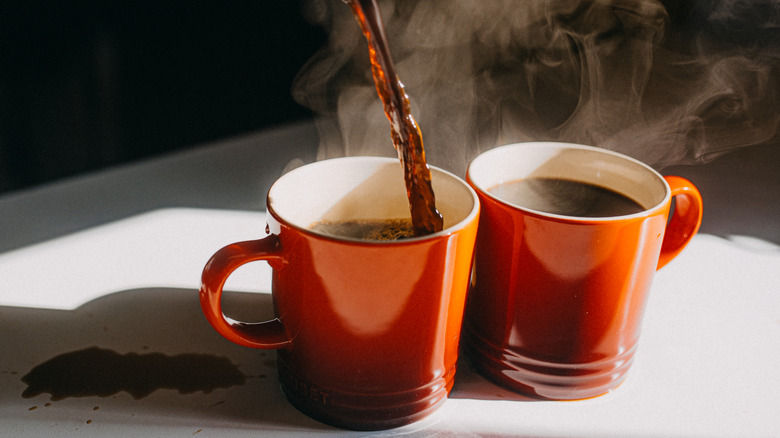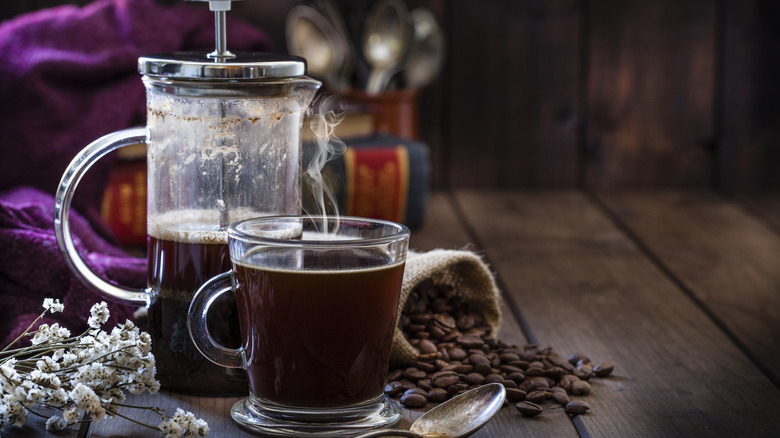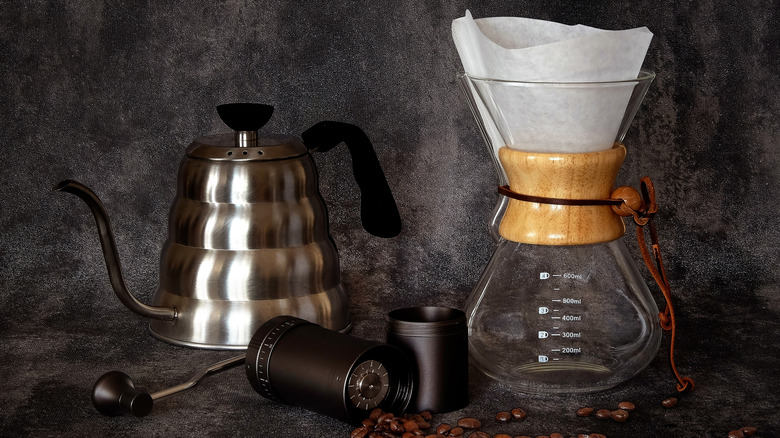What's The Difference Between A French Press & A Pour Over?
We may receive a commission on purchases made from links.
Each year, over half of the American population partakes in coffee regularly, and they drink a lot of it at home. But we've come a long way from the days of stovetop percolators and pre-ground, canned grocery store beans. Today, there are multiple brewing tools, each producing different results and appealing to different types of coffee drinkers. Among the most popular are the French press, which immerses the coffee grounds in water, and the pour over, which drips water through them.
The French press is a relatively easy method, producing a strong brew, whose intensity is based on how long you steep the grounds; it's the ideal technique for dark roast coffee lovers. In contrast, the pour over is more of a ritual as you must participate in the process from start to finish in order to produce the many flavor nuances that define the style.
Everything from the specific ratio of water to beans to the water temperature and grind size of the beans to the type of roast — light, medium, dark — contributes to the process, so expect a learning curve. Regardless of the technique, if you really want to up your coffee-brewing game, use a burr grinder for a precise grind and fresher flavor. And, whether you already have a sense of which technique appeals to you, or you plan to try both, take the time to experiment. Once you settle on the brew that's right for you, you can greet every day with the perfect cup of joe.
The elegant simplicity of the French press
The French press process is relatively straightforward. Ground coffee is put in a French press container, then water is poured over the grounds, which are fully immersed in the water. Both the pour over and the press require time for the coffee to bloom, achieved by pouring just enough water to cover the grounds. Then, wait for one minute, pour the remaining water over the coffee grounds, and let it sit for about four minutes. Lastly, insert the mesh plunger, slowly pressing it down to the bottom of the container. Really take your time — too fast, and your coffee may explode out of the spigot.
No matter the technique, it's important to measure the ground coffee in grams on a scale for the most accurate weight. Darker roasts, which are recommended for the French press, weigh less than lighter roasts. Likewise, the coarser grind size used in the press has more volume than the finer ones — and grinding too fine is a common mistake that ruins French press coffee. This not only allows for stronger extraction but also prevents grounds from escaping through the mesh into the liquid.
One of the hallmarks of a French press is a rich, often nutty, chocolatey character. To achieve this, a 15:1 ratio of water to grounds is a generally agreed upon starting point. Water temperature should be between 195 and 200 degrees Fahrenheit. While French press coffee is inherently strong, it's worth noting that if you leave it sitting for too long, it can become bitter because the water remains in direct contact with the grounds in the container.
The ritual of the pour over
While the French press needs nothing more than the actual pot, the pour over requires more equipment, including a paper filter and a coffee cone that is placed on top of the cup or a self-contained carafe like a Chemex to catch the coffee. Aficionados tend to use a gooseneck kettle as well; its curved spout with a small opening allows you to precisely direct the water over the grinds.
While daunting at first, once you get the hang of it, and if you have the right equipment, the technique for pour over coffee is relatively easy and almost zen-like. Grind consistency should be medium to medium-fine, resembling the size of table salt; this size prevents both over- and under-extraction. Water temperature should be between 195 to 202 degrees Fahrenheit for a lighter roast; dial it down to 200 for a medium one. Rinse your filter and the container with hot water to remove unwanted flavors and pre-heat the container.
Using a ratio between 14:1 to 20:1, depending on your preferred strength, cover the grounds with water and let them bloom for about 45 seconds. Next, gradually pour the remaining water over the grounds in two batches, starting from the center and working outward. Between each pour, gently swirl the water-coffee mixture, allowing the water to drip through. Once all the water has passed through, wait about three minutes and thirty seconds to extract all the flavors and enjoy.



